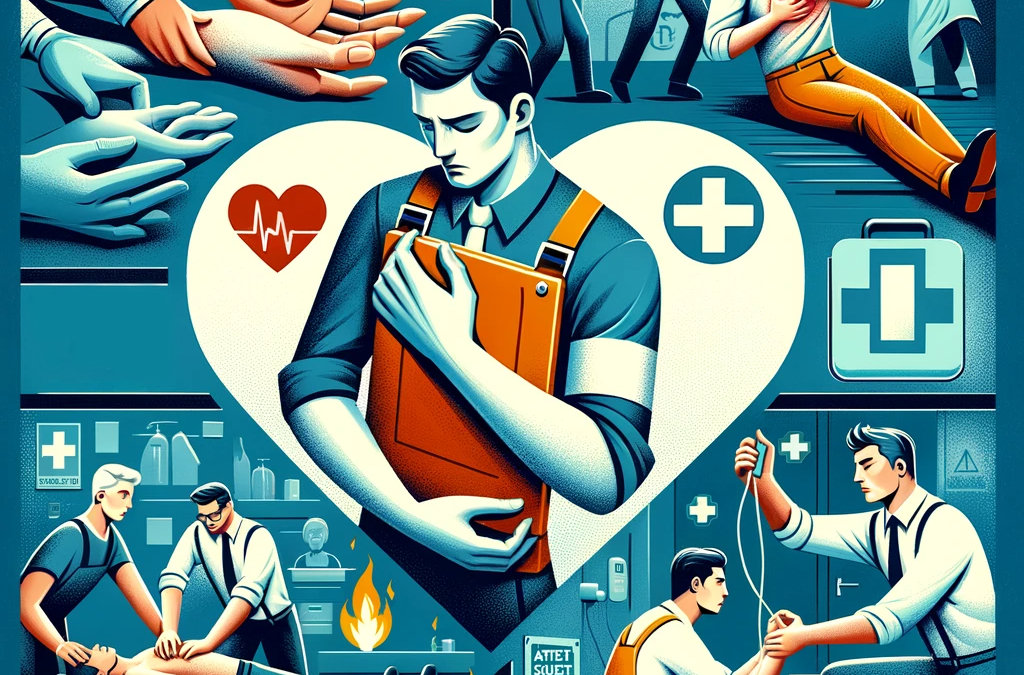10 Common Workplace Injuries and How First Aid Training Can Help
Workplace safety is a paramount concern for employers and employees alike. Despite stringent safety measures, accidents can and do happen.
Here’s where first aid training becomes invaluable. In this post, we’ll explore 10 common workplace injuries and how the skills learned in a Level 3 First Aid at Work Course can help manage and mitigate these situations.
1. Cuts and Lacerations
- Common Causes: Handling sharp objects, machinery accidents.
- First Aid Training Benefits: Teaches you to control bleeding, apply dressings, and recognize when stitches or professional medical attention is needed.
2. Sprains and Strains
- Common Causes: Lifting, slips, trips, and falls.
- First Aid Training Benefits: Learn to apply the R.I.C.E method (Rest, Ice, Compression, Elevation), and understand when to seek further medical care.
3. Burns
- Common Causes: Fire, hot surfaces, chemical exposure.
- First Aid Training Benefits: Understand how to cool burns effectively, cover the burn properly, and identify when a burn is severe enough to require emergency services.
4. Eye Injuries
- Common Causes: Splashes of hazardous substances, foreign bodies in the eye, cuts or scrapes on the cornea.
- First Aid Training Benefits: Learn how to rinse the eye, cover eye injuries appropriately, and when it’s crucial to get professional medical help.
5. Broken Bones
- Common Causes: Falls, heavy objects falling onto a person, accidents.
- First Aid Training Benefits: Teaches immobilization techniques, how to support the injury, and the signs that indicate a fracture or break.
6. Concussions and Head Injuries
- Common Causes: Falls, objects falling from a height, collisions.
- First Aid Training Benefits: Learn to recognize signs of a concussion, implement monitoring for deterioration, and understand when to seek immediate medical intervention.
7. Electrical Shocks
- Common Causes: Faulty equipment, accidental contact with exposed wires.
- First Aid Training Benefits: Understand how to safely approach and assist someone who has received an electric shock and the immediate steps to take while waiting for medical professionals.
8. Choking
- Common Causes: Swallowing small objects, food blockages.
- First Aid Training Benefits: Learn the Heimlich maneuver and back blows technique to clear the airway effectively.
9. Thermal Stress (Heat Stroke or Hypothermia)
- Common Causes: Extreme temperature environments, lack of hydration, inadequate clothing.
- First Aid Training Benefits: Recognize signs of thermal stress and learn immediate care techniques while awaiting further medical assistance.
10. Chemical Exposure
- Common Causes: Spills, improper handling of chemicals, lack of protective gear.
- First Aid Training Benefits: Understand decontamination procedures, the importance of eye wash stations, and when to seek emergency medical treatment.
Conclusion:
First aid training goes beyond just responding to accidents; it’s about preventing them where possible and minimizing their impact when they occur.
A Level 3 First Aid At Work Course equips individuals with the knowledge and skills to handle these common workplace injuries↗︎, fostering a safer work environment.
Remember, a well-trained first aider doesn’t just make the workplace safer; they make it more confident, resilient, and prepared.
Investing in first aid training is not just a regulatory fulfillment; it’s a commitment to the well-being of every person on the team.
Latest news, how to guides and more
Common Railway Safety Myths Debunked
Common Railway Safety Myths Debunked The railway industry, with its rich history and vast network, has been the subject of numerous myths and misconceptions over the years. Many of these myths pertain to safety, and while some may seem harmless, they can have...
Understanding Different Roles in Railway Safety
Understanding the Different Roles in Railway Safety The railway industry, with its vast network of tracks, trains, and stations, is a marvel of modern engineering and transportation. Ensuring the safe and efficient operation of this intricate system requires...
Beginner’s Guide to Railway Safety Standards and Protocols
A Beginner's Guide to Railway Safety Standards and Protocols The railway industry, with its vast network of tracks, trains, and stations, is a marvel of modern engineering and transportation. Ensuring the safe and efficient operation of this intricate system...


















